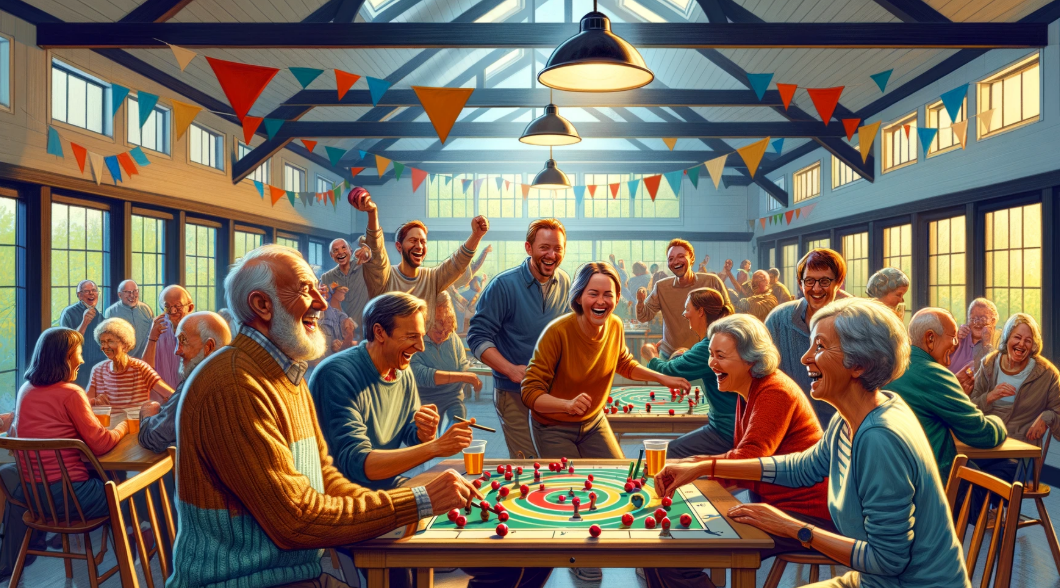In the rhythm of modern life, most people shuttle between two primary locations: the structured demands of workplaces and the private refuge of homes. Yet something essential happens in the spaces between—those gathering grounds where we connect without the roles that define us elsewhere. These “third places” form the often overlooked foundation of vibrant community life.
Beyond Work and Home: The Third Place Concept
Sociologist Ray Oldenburg first named this phenomenon in his seminal work examining spaces that anchor community life. Neither domestic nor professional, third places serve as neutral territory where diverse individuals gather informally, conversation flows naturally, and social bonds form across conventional boundaries.
The corner café where regulars greet each other by name. The community garden where neighbors exchange growing tips while tending adjacent plots. The independent bookstore hosting impromptu literary discussions. The skate park where youth from different neighborhoods practice alongside each other. All provide something increasingly rare—environments where people relate primarily as fellow humans rather than through professional titles or family roles.
What distinguishes genuine third places from other locations? They typically maintain low barriers to entry, both financial and social. They welcome lingering rather than rushing transactions. They foster conversation between previously unacquainted individuals. They accommodate regular attendance without formal membership requirements. Perhaps most importantly, they cultivate a playful mood where status hierarchies temporarily dissolve.
The Quiet Crisis of Vanishing Third Places
Many American communities face a troubling pattern—the steady erosion of traditional third places without adequate replacement. Strip malls replace town squares. Digital entertainment supplants community recreation. Corporate chains with standardized environments and high turnover rates displace locally-rooted establishments. Zoning regulations separate residential areas from commercial districts, requiring vehicular transportation between life domains.
According to research from the Project for Public Spaces, this trend correlates with declining social capital measurements across numerous communities. Their studies demonstrate that neighborhoods with abundant third places report stronger social networks, greater resilience during crises, and higher subjective wellbeing scores than comparable areas lacking such venues.
The implications extend beyond mere convenience. Without third places, communities lose crucial infrastructure for relationship formation outside predetermined social circles. Chance encounters between diverse community members diminish. Informal knowledge sharing contracts. The serendipitous connections that spark innovation, mutual aid, and collective action become increasingly rare.
The Distinctive Quality of Third Place Interaction
What happens in third places differs qualitatively from exchanges in other settings. Workplace conversations inevitably occur within professional hierarchies and instrumental goals. Home interactions necessarily exist within established family dynamics and domestic responsibilities. Third places, by contrast, allow people to temporarily step outside these defining structures.
This contextual shift creates unique social possibilities. Conversations wander beyond practical concerns to philosophical musings, community histories, or creative aspirations. Relationships form based on shared interests rather than assigned proximity. Intergenerational mixing occurs naturally as age becomes less relevant than shared enthusiasm. Newcomers find entry points to established community networks through casual participation rather than formal introduction.
As explained in our BuildBonding community design principles, these interactions create “weak tie” relationships essential for community resilience. While strong ties provide deep support during personal challenges, weak ties expand information access, opportunity awareness, and resource diversity critical for collective adaptation.
Designing Intentional Third Places
Creating vibrant third places requires understanding their essential characteristics. Physical design matters tremendously—spaces need varied seating arrangements accommodating both intimate conversations and larger gatherings. They benefit from “prospect and refuge” balances where visitors can observe community activity while maintaining comfortable personal boundaries. They require ambient sensory environments supporting conversation rather than overwhelming it.
Programming decisions prove equally important. Successful third places strike delicate balances between structure and spontaneity. Too much formal programming prevents organic interaction, while complete absence of organized activity sometimes creates social barriers for newcomers. The most effective venues offer “permission structures” for engagement without mandating specific participation forms.
Economic models significantly impact third place function. Spaces requiring continuous consumption inevitably limit accessibility and lingering. Those operating purely on government funding face sustainability challenges during budget constraints. Hybrid approaches often prove most resilient—community-owned cafés subsidizing gathering space through product sales, religious institutions opening facilities for broader community use, or business improvement districts funding public plazas maintained by local stakeholders.
Physical and Digital Third Places
While traditional third places exist primarily in physical locations, digital environments increasingly serve similar functions for some communities. Discord servers where interest groups gather daily, multiplayer gaming worlds supporting persistent communities, or specialized forums maintaining ongoing conversations all provide aspects of third place experience without geographic limitations.
According to The Atlantic’s research on digital communities, these virtual spaces offer certain third place advantages—accessibility regardless of mobility constraints, connection across geographic distances, and gathering around hyper-specific shared interests impossible within local population limitations. However, they typically lack the sensory richness, chance encounters with genuine difference, and embodied presence characterizing physical third places.
The most promising approaches integrate physical and digital dimensions. Community makerspaces maintain online forums extending workshop conversations. Neighborhood coffee shops provide digital community boards alongside physical gathering space. Gaming cafés host both in-person tournaments and online leagues. These hybrid models leverage respective strengths while mitigating limitations inherent to either approach alone.
Third Places for Diverse Community Needs
Different demographic groups require distinctive third place characteristics. Youth benefit from spaces offering both adult supervision and genuine autonomy, allowing identity exploration within appropriate safety boundaries. Elders need venues physically accessible regardless of mobility challenges while providing stimulating social engagement preventing isolation. Parents with young children require environments accommodating intergenerational needs simultaneously.
Cultural considerations similarly influence effective third place design. Some communities value boisterous, energetic environments where emotional expression flows freely. Others prefer quieter, contemplative spaces supporting thoughtful exchange. Some traditions emphasize food sharing as central to meaningful gathering, while others prioritize artistic or intellectual engagement. Recognizing these differences prevents imposing dominant cultural expectations that inadvertently exclude community segments.
Economic accessibility fundamentally determines who benefits from third places. Venues requiring significant expenditure for participation—whether through entrance fees, minimum purchase requirements, or expensive equipment—inevitably limit diversity regardless of stated intentions. Truly inclusive third places implement tiered accessibility models where those with greater resources subsidize participation for those with fewer means.
Creating New Third Places in Established Communities
Developing fresh third places within existing community fabrics requires navigating both practical and social challenges. Financially, traditional market mechanisms often undervalue social infrastructure compared to extractive uses with higher immediate profit margins. Regulatory frameworks frequently separate functions that beneficially mix within vibrant third places. Existing stakeholders sometimes resist change even when current arrangements inadequately serve community needs.
Successful initiatives typically combine grassroots enthusiasm with institutional support. Pop-up installations demonstrating concept viability before permanent investment. Temporary use agreements for vacant properties allowing experimental approaches with reduced financial risk. Partnerships between community organizations and property owners sharing both costs and benefits. Incremental improvements to existing spaces rather than comprehensive redevelopment requiring prohibitive initial investment.
The most resilient new third places arise from authentic community aspirations rather than imposed external visions. They build upon existing gathering patterns, amplifying natural congregation points already emerging within community life. They respect historical memory while addressing contemporary needs. They balance immediate activation with long-term sustainability planning.
Protecting and Nurturing Existing Third Places
While creating new third places remains essential, preserving existing ones deserves equal attention. Many communities lose foundational gathering spaces before recognizing their irreplaceable social value. The unassuming diner where multiple generations share counter space. The independently owned hardware store where practical knowledge passes between neighbors. The community theater providing both entertainment and creative outlet. All face mounting economic pressures without corresponding recognition of their community contribution.
Preservation strategies might include modified zoning recognizing social infrastructure value beyond tax generation potential. Legacy business designations providing tangible support for longstanding community anchors. Community ownership models transferring beloved institutions from retiring proprietors to neighborhood stakeholders. Financial incentives aligning economic sustainability with continued third place function.
Beyond external protection, third places require internal cultivation. Regular participants unknowingly serve as cultural stewards, modeling social norms that either welcome or discourage newcomers. Proprietors and managers make countless small decisions affecting inclusivity—whether initiating conversations across difference, addressing problematic behavior without excessive formality, or creating physical accommodations for diverse needs. These human factors ultimately determine whether spaces achieve their connecting potential regardless of physical characteristics.
The Future of Third Places
As communities navigate accelerating technological and social transformation, third places face both unprecedented challenges and emerging opportunities. Remote work blurs traditional boundaries between professional and personal domains while potentially freeing time previously consumed by commuting. Digital connection simultaneously enables and complicates in-person gathering. Economic consolidation threatens independent venues while creating hunger for authentic local experience.
Future-oriented communities increasingly recognize third places as essential infrastructure rather than luxury amenities. They incorporate gathering spaces within housing developments rather than relegating community function to separate districts. They repurpose underutilized institutional facilities like schools and libraries for broader community use beyond primary missions. They integrate third place planning within economic development strategies, recognizing social connectivity as foundational to innovation and resilience.
The most promising approaches treat third places as crucial components within comprehensive community ecosystems rather than isolated venues. They recognize that different spaces serve complementary social functions collectively meeting diverse community needs. They understand that physical environments, economic models, cultural practices, and human relationships all contribute to successful third places. Most importantly, they value these spaces as essential infrastructure for democratic society rather than optional amenities.
By reclaiming and reimagining the vital territory between work and home, communities create capacity for connection transcending utilitarian function. In these precious shared spaces, we rediscover something easily forgotten amidst modern fragmentation—the fundamental pleasure of human gathering for its own sake.





